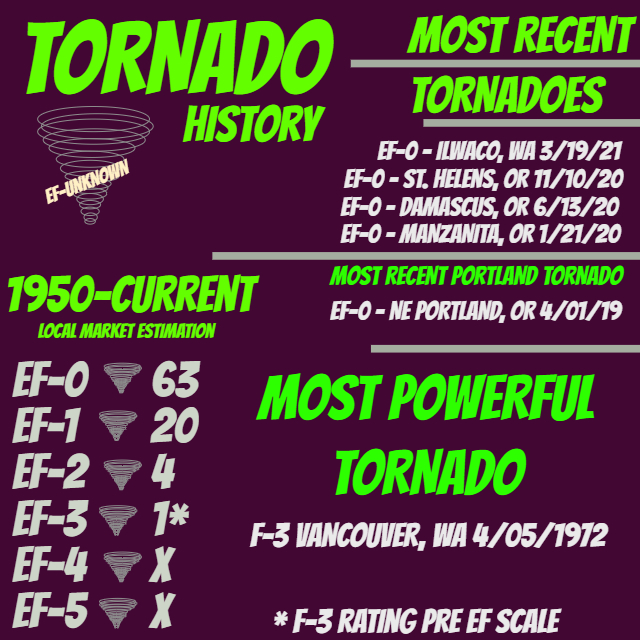EF-0 Tornado captured by Mike Boddington in Happy Valley, June 13, 2020 (KOIN)
PORTLAND, Ore. (KOIN) — Welcome back to our weather kids lesson series about tornadoes in the Pacific Northwest!
Today we are going over historical severe weather records, which is evidence tornadoes do happen in Oregon and Washington. In the previous lesson, we learned about tornado strength, the Enhanced Fujita scale, average yearly tornadoes and some of the ingredients that we need for a tornado.

One of our most recent tornadoes around Portland and Vancouver was the St. Helens tornado, which occurred on Nov. 10, 2020. It was a brief tornado that was caught on camera and brought damage to some of the homes and trees nearby. You can see a photo of some of the torn-up product on top of a back porch of a nearby house.
These are the type of tornadoes that hit the ground across the Pacific Northwest more often than not. In fact, over the last 88 tornadoes in the nearby area, over 70% of the tornadoes were ranked EF-0. As you may recall from the first lesson, that is the lowest on the scale, but it can still do some major damage.

CHECK OUT THE CHART BELOW

From 1950 to our current date in late March, 2021, we have an estimate of around 88 tornadoes. That takes into consideration nearby southwest Washington counties and others in the KOIN 6 viewing area. Notice that a substantial amount of those tornadoes are EF-0 rated after the storm survey team goes out and evaluates the damage.

However, there is a list of tornadoes that push some of the higher ratings, which is dated from 1950 to October 2019. We have only had one tornado that has reached the F-3 (prior to the enhanced fujita scale) rating going back through the record book and that was the April 5, 1972 tornado in Vancouver. The path of that tornado actually started in Multnomah county and the then went across the river into Clark county, where it made a large historic mark on our region.
You can see the path that the tornado took in the depiction below:

Here is a file photo of some of the damage from that power PNW tornado. You can say that this is very rare, it has happened only one time over the last 71 years. If you’re interested in the history of this tornado, you can read more here.

ANOTHER STRONG TORNADO

More recently, you may recall the tornado that occurred back in Oct. 14, 2016, along the Oregon coast in the city of Manzanita. This was an early morning tornado that stayed on the ground for about two minutes and traveled .70 miles and was ranked an EF-2 tornado. The National Weather Service in Portland surveyed this tornado and came back with an estimated max wind speed of 125 to 130 mph.
You can see the path of that tornado in the tweet that was sent out back in 2016. This was a busy day where there were multiple warned cells. This tornado started along the coast and then traveled through downtown and into nearby neighborhoods. This damaged local businesses, houses and trees. The photo above is part of the aftermath of that tornado.
Read about the Manzanita tornado from 2016 here and here.
WHAT ABOUT PORTLAND?
Our most recent tornado in Portland came in early July back in 2019. Only a few years ago! In fact, we had at least two tornadoes in Portland over the span of a year if you go back to October 2018. The tornado that dropped on July 1, 2019, was weak but it did enough damage to cause power lines to go down and uprooted some large trees. This was in busy area of Portland, which has a lot of houses and old trees. You can see the updated track of that tornado below. It started around 9th Avenue and came to an end near 38th Avenue, causing isolated damage along the path. Read more about this tornado here.
Now that you know a little bit of the history around here, you can start to see that we have all types of tornadoes in the PNW and that they can happen in most seasons! We have a lot more exciting tornado information to share with you. Make sure you tune into our weather lesson for next week.
NEXT WEEK: Part 3 will discuss the difference between tornado warnings and watches, we will also dive into radar coverage and the importance for spotting storms.